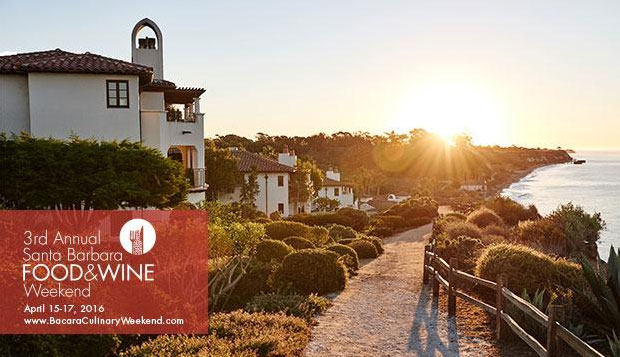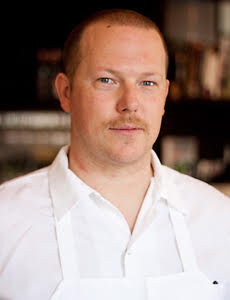by Bruce Steele | Mar 20, 2016 | WF News, What Chefs Say
Winfield Mangalitsa goes to LA – COCHON 555
Spring is always a busy time at Winfield Farm – and this year is proving to be busier than usual. Besides tending the new crop of Manga piglets, moving (and rebuilding) fence, herding pigs to new pastures, (praying for rain!), we’re ramping up our marketing efforts, with exciting new prospects – many in the City of Angels!
This spring we entered a 200-pound Mangalitsa pig into the Cochon 555 event in LA, which took place at the exclusive Viceroy Hotel in Santa Monica on Sunday March 13.
Cochon is a national competition conducted in 10 locations across the country, where five chefs each create six nose-to-tail bites, to be judged by an elite panel. Our partner in this venture was executive chef Jason Neroni from the Rose Café, the iconic restaurant in the heart of Venice Beach, California that has served locals and travelers alike since 1979. Chef Jason’s menu focuses on local Southern California cuisine with an international influence from his world travels – which included an invitation from the country of Spain to serve as a culinary ambassador, where he worked alongside some of Spain’s best chefs. Spain’s interest in Hungarian Mangalitsa pigs, ranked with Spanish Iberico as the only black-footed hogs allowed to be labeled ‘pata negra’, was instrumental in saving Mangalitsas from extinction. Chef Jason knows all about Mangalitsas — so he was the perfect partner for our Hungarian wooly pig.
Chef Jason’s menu for Cochon is a statement to his creativity – and his skill in displaying the rich flavor profile of Mangalitsa pork:
Testa pastrami and taleggio croissant / deli pickles (delicious)
Roasted pork meatballs (amazing!) / smoked burrata, chicarones (melt in your mouth crispy), tomato marmalade
Lasagna / fennel and pork sugo, porcini jus (in the opinion of many, the best bite in the competition!)
Buerre de jamon / blood butter, shaved prosciutto cotto and lomo, demi baguette (sooo good!)
Double ramen / pork fat, spring garlic, fermented turnips, poached belly, noodles (the best of all the ramens)
Stuffed trotter terrine / foie gras, black truffles, cognac soaked morels (absolutely elegant)
As participating farmers, we were able to sample the tastings of all the chefs ahead of the crowd that swarmed the Viceroy’s patio. Both Bruce and I voted for Chef Jason as the best bites in the competition!! We would have voted the same way even if our pig wasn’t competing! Chef Jason Neroni really did Winfield Farm Mangalitsa proud.
Thanks again, Chef!!
A photo gallery of Cochon activity
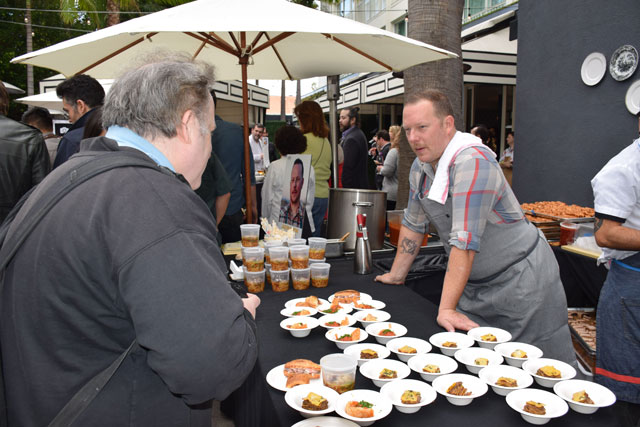 Chef Jason at his table
Chef Jason at his table
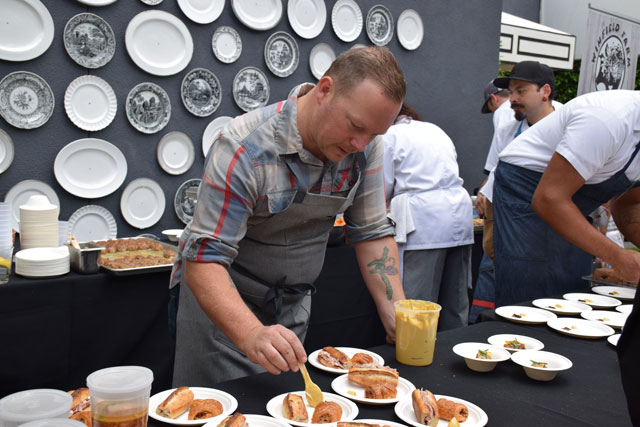 Chef Jason prepares a tasting
Chef Jason prepares a tasting
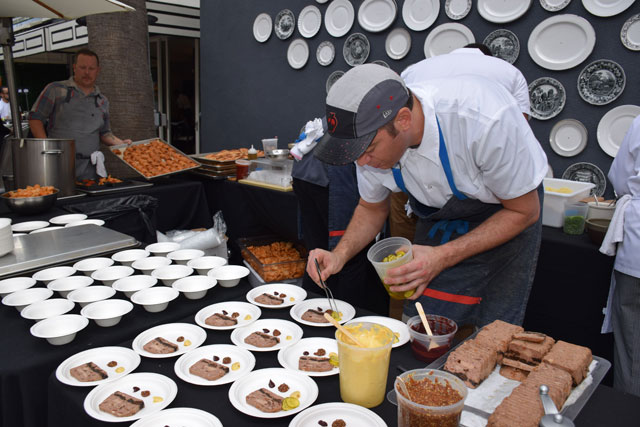 Prepping trotter terrine
Prepping trotter terrine
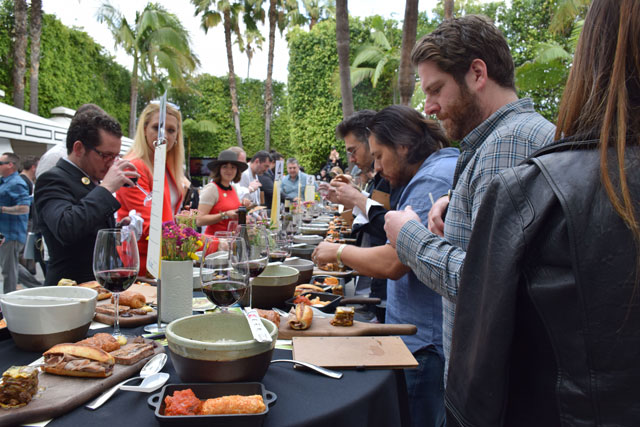 Judges sampling bites – #4 – Chef Jason, The Rose Cafe
Judges sampling bites – #4 – Chef Jason, The Rose Cafe
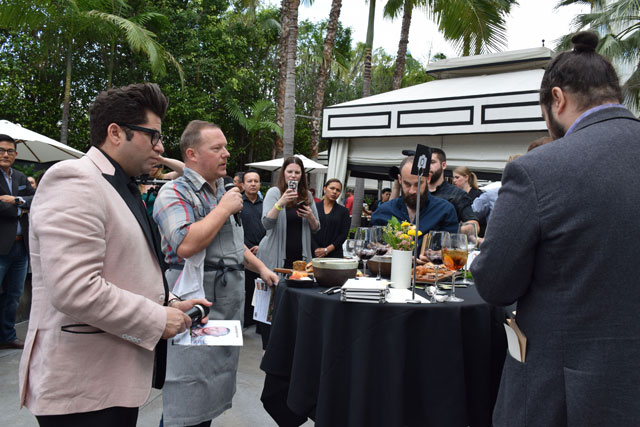 Chef Jason describing bites
Chef Jason describing bites
by Bruce Steele | Dec 29, 2015 | What Chefs Say
Behind the James Beard Award and the burgeoning restaurant empire, Linton Hopkins is really just an obsessive pork nerd. The Atlanta-based chef founded the Fellowship of Country Ham Slicers, which celebrates the craft of hand-slicing aged legs of swine, and created a collector’s edition Country Hams of the South placemat (read: treasure map) for the Atlanta Food & Wine Festival. The website for Holeman and Finch, his casual outpost in Atlanta, has a very scientific-looking photo on its homepage that claims ham can cure virtually any malady.
Hopkins’ devotion to swine is borderline religious, so it’s fair to ask: Where would a person like him find spiritual kinship with people who worship pork as much as he does?
The answer is The Salt Cured Pig—a private, invite-only group that can be found on the Facebook super highway somewhere between Bronies Unite Mid-Atlantic and Nuke the Whales.
“You can trust that The Salt Cured Pig is a community of people who actually care about how we procure, practice, and preserve our craft, “ said Hopkins.
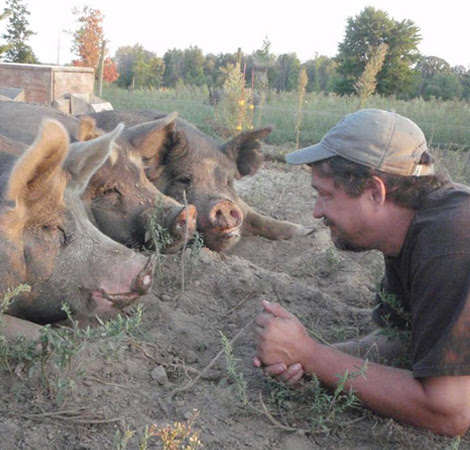 The Salt Cured Pig founder John Patterson has seen the group grow to over 8,000 members.
The Salt Cured Pig founder John Patterson has seen the group grow to over 8,000 members.
I. A Global Network of Swine Fanatics
The Salt Cured Pig was founded in 2010 by Michigan native John Patterson, who has since watched his cultish community of swine enthusiasts grow to more than 8,000 members. An average of 100 new people are invited into the group every week by friends already on the inside.
This is a place where rockstar butchers and unadulterated porknography take precedence over the media’s breathless rediscovery of edible plant life, and Patterson loves it. And why wouldn’t he? America’s most knowledgeable farmers, meat processors, butchers, charcutiers, chefs, and educators have essentially open-sourced their collective wisdom in his forum.
America’s most knowledgeable farmers, meat processors, butchers, charcutiers, chefs, and educators have open-sourced their collective wisdom in the forum. It’s like getting private batting lessons from George Brett, the Kansas City Royals Hall of Famer
“This was a selfish venture in the beginning,” said Patterson. “I bankrupted myself buying cured meats at Zingerman’s one day and decided, if people have been doing this for thousands of years, I should just do it myself.”
The first leg of The Salt Cured Pig journey is all about Patterson’s original vision of setting out on one’s own into the wide world of DIY curing. Certainly that was my experience when I joined shortly after the group’s inception. For the better part of that first year of membership, my 900-square-foot abode in Washington, D.C. was filled with various meat-curing experiments. Pancetta strung up in the kitchen window and pork jowl hanging from an old planter hook in the corner. Every time I had a question or near meltdown, I went to the group.
Answers would come from people like Josh and Jessica Applestone, the forebears of nouveau butchery at Fleisher’s Pasture-Raised Meats, or Kate Hill, an American expat living in Gascony who runs a pork-centric cooking school, Kitchen at Camont, with a family of French master pig farmers and butchers named the Chapolards. It was like getting private batting lessons from George Brett, the Kansas City Royals Hall of Famer who was my childhood hero. I achieved delicious successes and a few spectacular failures (amazingly, my wife still agreed to marry me that year). More than once or twice, I considered training to become a butcher and opening a shop.
“Where else can charcuterie enthusiasts around the world get access to an incredible network like this 24 hours a day?” asked Hill, a group administrator. “When I’m having a morning café au lait in France, someone in Tucson is tending his smoker, a charcutier in Bangkok is talking to a pig farmer in Australia, and a Korean chef is sharing his wares with us all.”
II. Chefs Find Inspiration
A search of the group brings up some culinary star-power, including Craig Deihl, Jonathan Waxman, Nate Anda, Paul Kahan, David Varley, Ryan Farr, Lee Anne Wong, Tom Mylan, and Celina Tio. Peter Kaminsky, whose 2005 book Pig Perfect introduced the world to Chuck Talbott’s pioneering research on heritage pig breeds and flavor, is also a member (as is Talbott). Despite their high-profile status, some still look to The Salt Cured Pig as a place for continuous learning and experimentation.
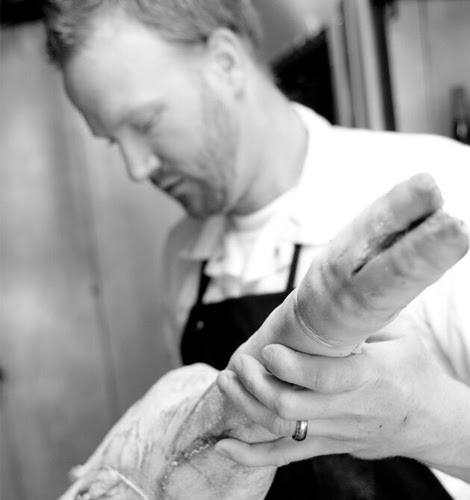 Chefs like Rick McKee (pictured above) and Craig Deihl credit the group with inspiring dishes that appear on his menu. (Photo: John Smoak)
Chefs like Rick McKee (pictured above) and Craig Deihl credit the group with inspiring dishes that appear on his menu. (Photo: John Smoak)
“What’s really important to me is the way people are open and post photos about failure, which is so important to getting better,” said Deihl, whose charcuterie work at Cypress and Artisan Meat Share in Charleston is second to none in the U.S. right now. “Watching people share non-pork ideas, like salmon belly nduja and shrimp sausage and swordfish bacon, has also made me think about what new things I can do in the restaurants.”
VIPs like Deihl have undoubtedly had an impact in The Salt Cured Pig forum, but the lesser-known professionals represent the group’s real value. These are the workaday evangelists who are carrying forward the movement for responsible pig husbandry and curing.
“I think it is a really valuable resource for anyone in the restaurant business,” said Justin Brunson, owner and executive chef at Old Major, the Denver Bacon Company, and a constellation of other meat-driven establishments in the Mile High City. “I get tips on chili pastes, peppers, and salts for sausage and curing in the group all the time, and the members gave me a ton of help on specs when I built my first curing chamber.”
Brunson is known among pork nerds, and he and others like him are the most active in the group’s conversation strings, offering hard-won wisdom to less-seasoned members and doing their best to keep the group focused on safety, tradition, and quality. Others include Cathy Barrow, the writer behind MrsWheelBarrow.com; Adam Danforth, the James Beard Award-winning author and butcher; Carl Blake, who runs Rustik Rooster Farms in Iowa; Brady Lowe, the founder of Cochon 555; Bob Perry, Chef in Residence at the University of Kentucky College of Agriculture; and Bob Del Grosso, a micropaleontologist by training who has taught for decades at the Culinary Institute of America and other institutions.
“Before the advent of groups like this, the likelihood that someone like Carl Blake would be sharing hog-farming tips with people in Michigan and Austria was almost nil,” said Del Grosso. “During my tenure as a Salt Cured Pig administrator I’ve seen countless examples of people who, inspired by something they read there, pick up knives and saws to butcher their food, pick up stakes and move to farms. That is significant.”
“I look at the group every day to see what people are doing,” said Brandon Johns, chef-owner of Grange Kitchen & Bar, an Ann Arbor restaurant that counts other members among its regular patrons. “It’s great to see them using old-school technique, like hand-cutting sausage, that you can’t find anywhere anymore, and I’m always getting inspiration to try new things.”
There’s the issue of the pesky vegetarians who have regularly infiltrated the group, calling ironically for Patterson’s slaughter.
With all the collective wisdom and shared support, is the forum having a wider impact? Anecdotally, those of us who have been in the group since early on have seen growth in the number of heritage-pig farms, professional curing operations, and restaurants doing in-house charcuterie. According to a three-year study by the Livestock Conservancy, an organization that works on genetic conservation and promotion of heritage-breed animals, the numbers of heritage-breed pigs overall have been growing in recent years. Just a couple days ago, member Stephen Prochaska announced the opening of his new Cedar Rapids, Iowa sausage shop, The Sausage Foundry, and thanked the group for insights and input.
“A goal in the beginning was to make sure that these things wouldn’t just be fads,” said Patterson. “I hope we are helping secure a better future for meat in America.”
III. The Swine Schism, Militant Vegetarians, and the Power of Community
That remains to be seen, but we wouldn’t even be having this conversation without the committed core constituency in The Salt Cured Pig. Whether the center can hold is another question, because Patterson’s ride hasn’t all been pillowy white fatback and silky sausage gravy. The group has, at times, been greased by drama.
Firstly, there’s the issue of the pesky vegetarians who have infiltrated the group regularly, calling (ironically) for Patterson’s slaughter and, on more than one occasion, getting him thrown off of Facebook (he maintains aliases including Bobby Berkshire, named after the famous breed of curing hogs). One woman was so aggressive that Patterson did a little research and cornered her with Google Maps evidence of a charcoal grill in her backyard. She backed off and the veg hackers have been quiet recently.
Patterson’s ride hasn’t all been pillowy white fatback and silky sausage gravy. The group, like so many young phenomena, has at times been greased by drama.
Then there was the infamous swine schism. In the early days, when The Salt Cured Pig was small, most of the members were in it to share advanced practices, but things changed as the numbers roared upwards. Some griped that bacon became too dominant a theme (is that possible?) and the comment strings got too heated and meme-heavy. The full administrative team tried to exert some quality control, but the divide had already calcified. A breakaway faction of accomplished home charcutiers, led by bloggers Scott Stegen and Jason Molinari, peeled off and formed Sausage Debauchery, a rival group with a less freewheeling and more pedantic bent. To date, Sausage Debauchery has more than 5,400 members.
“I think the two communities are alternate sides of the same coin: The Salt Cured Pig is great for people just getting into the curing and overcoming their fear, and Sausage Debauchery is like a watering hole for what I call the ‘meat mafia,’ those of us who live the craft every day,” said Hank Shaw, the James Beard Award-winning blogger and author of Hunt, Gather, Cook: Finding the Forgotten Feast and Duck, Duck, Goose.
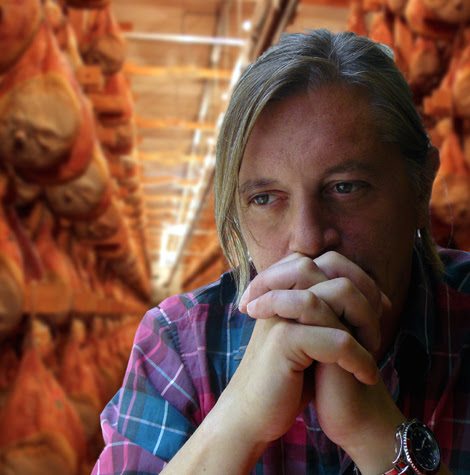
Paolo Sossai, a spiritual guide for pork forums like The Salt Cured Pig, embodied the restless pursuit of quality swine products.
Many people hold dual membership and foster friendships in both groups, and the kinship shows through more than any split—as the story of Paolo Sossai makes clear. Sossai, who died from cancer last month, may have been the pioneering digital community organizer for home charcutiers as the head of the Salumi Casalinghi Forum, an Italian listserv where he shared old-world techniques and facilitated discussion on the craft. He was a mentor to many in both The Salt Cured Pig and Sausage Debauchery, dropping in and out of discussions in both groups to offer patient, broken-English–infused explanations of things like the definition of porchetta di testa, and the regional difference between sopressa and sopressata. His death brought forth an outpouring of sympathy.
“Paolo’s legacy is the real sense of community in terms of passion for craft, willingness to help and a wonderful intolerance of showiness or lack of humility,” said John Gower, a member of both The Salt Cured Pig and Sausage Debauchery, who raises pigs on a sustainable farm in North Devon, England. “In life and death, he has only encouraged this sense all the more amongst many of us.”
Sossai, like Patterson, Stegen, and many others, was the bond that held the communities together and pushed them forward towards a vision of better, more sustainable farms and food. Which reminds me: I have a big batch of heritage pork shoulder in the freezer that needs my attention.
Read the original post: http://firstwefeast.com/eat/the-pork-obsessives/
by Bruce Steele | Oct 16, 2015 | What Chefs Say
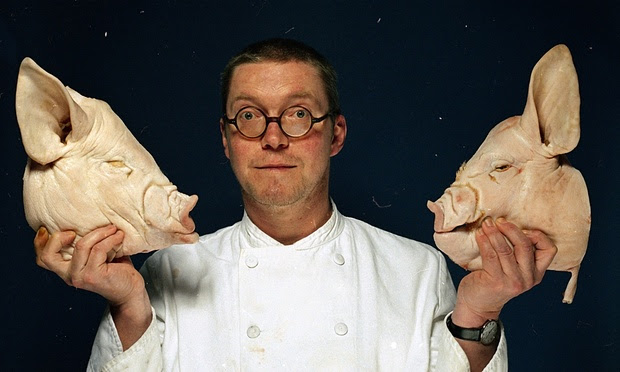
St John’s Fergus Henderson. King of nose to tail eating. Photograph: Suki Dhanda for the Observer
Boning a pig’s head isn’t easy. My friend, the food historian Dr Annie Gray, tried it once. It took her and a friend five hours. She was following the 1846 instructions of Charles Elmé Francatelli, once chef to Queen Victoria, who was an old hand at the whole pig boning business. The key is to get a head severed at the second vertebrae, so that when you have tunnel-boned the skull, working the blade carefully about the jaw and skull, and then refilled it with the forcemeat, you have a flap of skin to be re-stitched at the back.
Before you can do that, you have to take the pig’s head, the eyes stitched closed, and smear it with six pounds of salt, handfuls of saltpetre, sugar, cloves, mace, garlic, thyme, marjoram and basil. It then needs to be submerged in a quart of port for two weeks and turned every day.
Next you stuff it with sausagemeat, and a mixture of tongue, fatty bacon, truffles and pistachio kernels. It now needs to be wrapped in butter-rubbed muslin and simmered in a stock full of cow’s feet and grouse carcasses for five hours, before being allowed to cool. Finally, decorate it with piped lard and separately baked pastry pieces. Queen Victoria had a head like this on her table at Christmas every year. Apparently the upper classes have long appreciated the ceremony that attends the boning of pig heads.
Preparing a pig’s head this way is tricky, of course, because you’re trying to keep it in one piece. If that’s not an issue you can cut off the pieces you want: the cheeks ears and snout. Pig cheeks braise beautifully. The ears have many uses. Fuchsia Dunlop has a great recipe in her Revolutionary Chinese Cookbook for an aromatic salad, which is all about chilli oil and sesame oil, and the thin slices of gelatinous skin sandwiching a crunch of cartilage.
Alternatively, April Bloomfield does a crispy pig’s ear salad, in which they become the biggest curve of pork scratching imaginable. The Pitt Cue boys recommend boiling them for a couple of hours and refrigerating overnight, before cutting into strips, deep frying them and serving with a habanero sauce. At Duck & Waffle, they dust crispy strips of ear with a sweet salty mix. They taste like Frazzles.
If this doesn’t appeal, you can always boil a head until the flesh falls away. Next, remove all the meat. There are now two ways to go. Spice it up the old English way with lots of mace and white pepper, and press it to make a classic brawn. Or (again, pace Pitt Cue) form it into a sausage bound in clingfilm. Once refrigerated and set, cut it into discs, bread crumb and deep fry to make pig’s head croquettes.
Alternatively, take the whole thing and, as they do at St John, slow roast it for hours until the meat falls from the bones, and the skin shatters beneath your teeth like savoury glass. Think of this as a self-boning pig’s head, which is a neat trick if you can pull it off. Of course, there may be other ways to go about boning a pig’s head.
Originally posted: http://www.theguardian.com/






